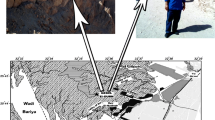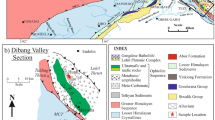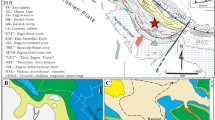Abstract
The carbonate metasediments of Pindwara-AbuRoad Belt (PARB) in the Sirohi district belongs to the Kumbhalgarh Group of the South Delhi Terrane (SDT). The litho-assemblages associated are quartzite, carbonate, mica schist, phyllite, metavolcanics, and granitoids. The present study is made on impure marble and calcsilicates of the study area. The carbonates show mineralogical variations with indiscernible field boundaries. The carbonates composed of calcite, diopside, hornblende, tremolite, actinolite, biotite, muscovite, epidote, quartz, plagioclase with minor proportion of apatite, sphene, garnet, sericite, kyanite, zircon, opaque, and broadly may be termed as calc-silicates. The mineral chemistry, major, trace elements, and REE geochemistry of the carbonates reveal the nature of protolith, provenance, depositional environment, spatial and temporal constraints on metamorphism, and on going tectonic process. The study suggests that the PARB carbonate metasediments were derived from a varied proportion of terrigenous and quartzo-feldspathic felsic provenance and deposited in less saline shallow marine environment in an intra-continental rift setting. These exhibit amphibolite to green-schist facies metamorphism, accompanied by polyphase deformation. The metasediments of the region indicate the Meso-Neoproterozoic transition during the Delhi Orogeny in SDT.
Similar content being viewed by others
References
Barton, M.D., Ilchik, R.P., Marikos, M.A. (1991) Metasomatism. Rev. Mineral., v.26, pp.321–350.
Brand, U. (1989) Biogeochemistry of Late Palaeozoic North American brachiopods and secular variation of seawater composition. Biogeochemistry, v.7(3), pp.159–193.
Choudhary, A.K., Gopalan, K., Sastry, A.C. (1984) Present status of the geochemistry of the Precambrian rocks of Rajasthan. Tectonophysics, v.105, pp.131–140.
Condie, K.C., Dengate, J. and Cullers, R.L. (1995) Behaviour of rare earth elements in a palaeoweathering profile on granodiorite in the Front Range, Colorado, USA. Geochim. Cosmochim. Acta, v. 59(2), pp.279–294.
Condie, K.C., Lee, D. and Farmer, G.L. (2001) Tectonic setting and provenance of the Neoproterozoic Uinta Mountain and Big Cottonwood groups, northern Utah: constraints from geochemistry, Nd isotopes, and detrital modes. Sediment. Geol., v. 141, pp.443–464.
Coulson, A.L. (1933) The geology of Sirohi state, Rajputana. Geol. Surv. India, v.1, pp.1–166.
Cox, R. and Lowe, D. R. (1995) A conceptual review of regional-scale controls on the composition of clastic sediment and the co-evolution of continental blocks and their sedimentary cover. Jour. Sediment. Res., v.65(1a), pp.1–12.
Deb, M., Thrope, R.I., Krstic, D., Corfu, F., Davis, D.W. (2001) Zircon U-Pb and galena Pb isotope evidence for an approximate 1.0 Ga terrane constituting the western margin of the Aravalli-Delhi orogenic belt, northwestern India. Precambrian Res., 108, pp.195–213.
Dharma Rao, C.V., Santosh, M., Sung Wong Kim, Shengrong Li, (2012) Arc magmatism in the Delhi Fold Belt: SHRIMP U-Pb zircon ages of granitoids and implications for Neoproterozoic convergent margin tectonics in NW India. Jour. Asian Earth Sci., doi:https://doi.org/10.1016//j.jseaes.2012.09.007.
Dutt, A., Singh, A.K., Srivastava, R.K. and Oinam, G. (2021) Evidence of melt-and fluid-rock interactions in the refractory forearc peridotites and associated mafic intrusives from the Tuting-Tidding ophiolites, eastern Himalaya, India: Petrogenetic and tectonic implications. Geol. Jour., v.56(4), pp.2082–2110.
Dutta, R., Bhu, H., Purohit, R. and Sharma, K.K. (2021) Geology of granitoids of Pindwara-Abu Road Belt from Mesoproterozoic Delhi Supergroup: Tectonic implications. Jour. Earth Syst. Sci., v.130(3), pp.1–17.
Dutta, R. (2022) Crustal Evolutionary Studies of the Mesoproterozoic LithoAssemblages of South Delhi Terrane from Sirohi District, Rajasthan. Unpublished Ph.D. Thesis (Department of Geology, Mohanlal Sukhadia University).
Garcia, D., Fonteilles, M. and Moutte, J. (1994) Sedimentary fractionations between Al, Ti, and Zr and the genesis of strongly peraluminousgranites. Jour. Geol., v.102(4), pp.411–422.
Gupta, S.N. and Murthy, M.V.N. (1995) Geological Map of the Precambrians of the Aravalli Region, Southern Rajasthan and Northeastern Gujarat, India: SN Gupta et al.; Co-ordinator MVN Murthy. Geol. Surv. India.
Gupta, S.N., Arora, Y.K., Mathur, R.K., Iqballuddin, Prasad, B., Sahai, T.N. and Sharma, S.B. (1997) The Precambrian Geology of the Aravalli Region, Southern Rajasthan and Northeastern Gujarat. Mem. Geol. Surv. India, v. 123, pp.1–262.
Gupta, S.N., Arora, Y.K., Mathur, R.K., Iqbaluddin, Prasad Balmiki, Sahai, T.N., and Sharma, S.B. (1980) Lithostratigraphic map of Aravalli region, southern Rajasthan and northeastern Gujarat: Hyderabad. Geol. Surv. India Publ.
Hahn, G., Kodl, G., de Wall, H., Schulz, B., Bestmann, M., Chauhan, N.K. (2020). Deformation in the Aravalli Supergroup, Aravalli Delhi Mobile Belt, NW India and Tectonic significance. In: T.K. Biswal et al., (Eds.), Structural Geometry of Precambrian Mobile Belts of Indian Subcontinent. Soc. Earth Scient Series. Springer Publ., pp.23–55.
Jaideep, K.T., Kaur, P., Chaudhri, N., Manisha (2020) First record of circa 970Ma post-collisional A-type magmatism in the Sendra Granitoid suite, central Aravalli orogen, northwest India. Curr. Sci., v. 118(5), pp.801–808.
Jones, B. and Manning, D. A. (1994) Comparison of geochemical indices used for the interpretation of palaeoredox conditions in ancient mudstones. Chem. Geol., v.111(1–4), pp.111–129.
Khanna, P.P. (2009) An appraisal of ICP-MS technique for determination of REEs: long term QC assessment ofsilicate rock analysis. Him. Geol., v.30, pp.95–99.
Kinsman, D.J. (1969) Interpretation of Sr (super+ 2) concentrations in carbonate minerals and rocks. Jour. Sediment. Res., v.39(2), pp.486–508.
Land, L.S. and Hoops, G.K. (1973) Sodium in carbonate sediments and rocks; a possible index to the salinity of diagenetic solutions. Jour. Sediment. Res., v. 43(3), pp.614–617.
Leake, B.E., Woolley, A.R., Arps, C.E., Birch, W.D., Gilbert, M. C., Grice, J.D., … and Youzhi, G. (1997) Nomenclature of amphiboles; report of the subcommittee on amphiboles of the International Mineralogical Association, Commission on New Minerals and Mineral Names. Canadian Mineral., v.35(1), pp.219–246.
Lucas-Tooth, J. and Pyne, C. (1963) The accurate determination of major constituents by X-ray fluorescent analysis in the presence of large interelement effects. Advan. X-ray Analysis, v.7, pp.523–541.
Madhavaraju, J. and Ramasamy, S. (1999) Rare earth elements in limestones of Kallankurichchi formation of Ariyalur group, Tiruchirapalli Cretaceous, Tamil Nadu. Jour. Geol. Soc. India, v.54(3), pp.291–301.
Maheshwari, A., Sial, A.N., Purhoit, R. and Bhu, H. (2009) Characterization of C isotope variability in the Delhi Supergroup, northwestern India and the Mesoproterozoic ocean. Internat. Geol. Rev., v.51(5), pp.456–472.
McLennan, S.M., Fryer, B.J. and Young, G.M. (1979) The geochemistry of the carbonate-rich Espanola Formation (Huronian) with emphasis on the rare earth elements. Canadian Jour. Earth Sci., v.16(2), pp.230–239.
Meert, J.G. and Torsvik, T.H. (2003) The making and unmaking of a supercontinent: Rodinia revisited. Tectonophysics, v.375(1–4), pp.261–288.
Mehmood, M., Yaseen, M., Khan, E.U. and Khan, M.J. (2018) Dolomite and dolomitization model-a short review. Internat. Jour. Hydrol., v.2(5), pp.549–553.
Morimoto, N. (1988). Nomenclature of pyroxenes. Mineral. Petrol., v.39(1), pp.55–76.
Mukherjee, A.D., Bhattacharyya, P.K. and Bhattacharya, H.N. (1992) Petrotectonics of a southern segment of the polymetallic sulphide-bearing Proterozoic Delhi Mobile Belt, Rajasthan, India and its implications. In: Metallogeny related to tectonics of the Proterozoic mobile belts. Oxford and IBH Publ., pp.253–270.
Pandit, M.K., Carter, L.M., Ashwal, L.D., Tucker, R.D., Torsvik, T.H., Jamtveit, B., Bhushan, S.K. (2003). Age, petrogenesis and significance of 1 Ga granitiods and related rocks from the Sendra area, Aravalli Craton, NW India. Jour. Asian Earth Sci., v.22, pp.363–381.
Pandit, M.K., de Wall, H., Daxberger, H., Just, J., Bestmann, M., Sharma, K.K. (2011) Mafic rocks from Erinpura gneiss terrane in the Sirohi region: possible ocean-floor remnants in the foreland of the Delhi Fold Belt, NW India. Jour. Earth Syst. Sci., v.120, pp.627–641.
Petterson, M.G. and Windley, B.F. (1986) Petrological and geochemical evolution of the Kohistan arc-batholith, Gilgit, N. Pakistan. Geol. Bull. Univ. Peshawar, v. 19, pp.121–149.
Pettijohn, F.J. (1948). A Preface to the Classification of the Sedimentary Rocks. Jour. Geol., v.56(2), pp.112–117.
Purohit, R., (2005) An Overview of carbon and oxygen isotope studies from Precambrian carbonates of the northwestern Indian shield. Indian Jour. Geochem., v.20, pp.91–102.
Purohit, R., Papineau, D., Kroner, Alfred, Sharma, K.K., Roy, A.B. (2012). Carbon Isotope Geochemistry and Geochronological Constraints of the Neoproterozoic Sirohi Group from Northwestern India. Precambrian Res., v.220–221, pp.80–90.
Rankama, K. and Sahama, T.G. (1950) Geochemistry. University of Chicago Press.
Roser, B.P., Cooper, R.A., Nathan, S., Tulloch, A.J. (1996) Reconnaissance sandstone geochemistry, provenance andtectonic setting of the lower Paleozoic terranes of the WestCoast and Nelson, New Zealand. Jour. Geol. Geophys., v.39, pp.1–16.
Roy, A.B., Das, A.R. (1985) A study on the time relations between movements, metamorphism and Granite emplacement in the Middle Proterozoic Delhi supergroup rocks of Rajasthan. Jour. Geol. Soc. India, v.26, pp.726–733.
Roy, A.B., Jakhar, S.R. (2002) Geology of Rajasthan (Northwest India) Precambrian to Recent. Scient. Publi. India, p.421.
Roy, A.B., Purohit, R. (2015) Lithostratigraphic, Geochronologic, and Depositional framework of the Precambrian basins of the Aravalli Mountains and adjoining areas, Rajasthan, India. In: Mazumder, R. and Eriksson, P.G. (Eds.), Precambrian Basins of India: Stratigraphic and Tectonic Context. Geol. Soc. London, Mem., v. 43, pp.55–66.
Roy. A.B., Purohit, R., (2018) Aravalli Protocontinent, Indian Shield: Precambrian Evolution and Phanerozoic Reconstitution. Elsevier, pp.175–212.
Saini, N.K., Mukherjee, P.K., Rathi, M.S. and Khanna, P.P. (2000) Evaluation of energy dispersive x ray fluorescence spectrometry in the rapid analysis of silicate rocks using pressed powder pellets. X Ray Spectro.: An Internat. Jour., v.29(2), pp.166–172.
Sharma, R.S. (1990) Metamorphic evolution of rocks from the Rajasthan craton, NW Indian shield. Develop. Precambrian Geol., v.9, pp.349–366.
Singh, P.K. and Khan, M.S. (2017) Geochemistry of Palaeoproterozoic rocks of Aravalli supergroup: implications for weathering history and depositional sequence. Internat. Jour. Geosci., v.8(10), pp.1278–1299.
Singh, S.P. (1988) Stratigraphy and Sedimentation pattern in the Proterozoic delhiSupergroup, Northeastern Rajasthan. In: Roy, A.B., (Ed.), Precambrian of the Aravalli Mountain Belt. Geol. Surv. India Mem., v.7, pp.193–205.
Singh, Y.K., Waele, B.D., Karmakar, S., Sarkar, S., Biswal, T.K. (2010) Tectonic setting of the Balaram-Kui-Surpagla-Kengora granulites of the South Delhi Terrane of the Aravalli Mobile Belt, NW India and its implication on correlation with the East African Orogen in the Gondwana assembly. Precambrian Res., v.183(4), pp.669–688, doi:https://doi.org/10.1016/j.precamres.2010.08.005.
Somayajulu, B.L.K., Yadav, D.N. and Sarin, M.M. (1994) Recent sedimentary records from the Arabian Sea. Proc. Indian Acad. Sci.-Earth Planet. Sci., v. 103(2), pp.315–327.
Sun, S.S. and McDonough, W.F. (1989) Chemical and isotopic systematics of oceanic basalts: implications for mantle composition and processes. Geol. Soc. London, Spec. Publ., v. 42(1), pp.313–345.
Taylor, S.R. and McLennan, S.M. (1985) The continental crust: its composition and evolution. Blackwell, Oxford, pp.1–312.
Tlig, S. and M’rabet, A. (1985). A comparative study of the rare earth element (REE) distributions within the Lower Cretaceous dolomites and limestones of Central Tunisia. Sedimentol., v.32(6), pp.897–907.
Tucker, M.E. and Bathurst, R.G. (Eds.).(2009) Carbonate diagenesis. John Wiley & Sons.
Wronkiewicz, D. J., &Condie, K. C. (1990). Geochemistry and mineralogy of sediments from the Ventersdorp and Transvaal Supergroups, South Africa: cratonic evolution during the early Proterozoic. Geochim. Cosmochim. Acta, v.54(2), pp.343–354.
Zhao, J.H., Pandit, M.K., Wang, W., Xia, X., (2018) Neoproterozoic tectonothermal evolution of northwest India: Evidence from geochemistry and geochronology of granitoids. Lithos, v.316–317, pp.330–346.
Acknowledgments
The authors wish to acknowledge the funding agency DST, GOI for their support in this research work through WOS-A scheme (Project Reference No: SR/WOS-A/EA-1017-B/2015). Acknowledgments are due to Prof. S. C. Patel, Department of Earth Sciences, Indian Institute of Technology, Bombay for the help rendered in EPMA facilities and to Wadia Institute of Himalayan Geology, Dehradun for rendering geochemical analysis of selected samples. The authors are thankful to the Heads of the department, MohanlalSukhadia University for providing necessary working facilities. Authors are thankful to Mr. RachitParihar for rendering help in this work. The authors are also thankful to the anonymous reviewers, whose suggestions have improved the manuscript.
Author information
Authors and Affiliations
Corresponding author
Rights and permissions
About this article
Cite this article
Dutta, R., Purohit, R., Bhu, H. et al. Petrology and Geochemistry of Carbonate Metasediments from Pindwara- Aburoad Belt in the Southern Part of South Delhi Terrane: Implications for Protolith, Provenance and Tectonic Setting. J Geol Soc India 99, 710–722 (2023). https://doi.org/10.1007/s12594-023-2371-4
Received:
Accepted:
Published:
Issue Date:
DOI: https://doi.org/10.1007/s12594-023-2371-4




